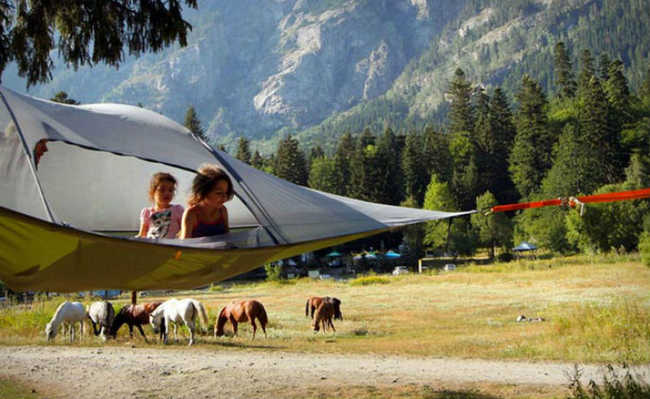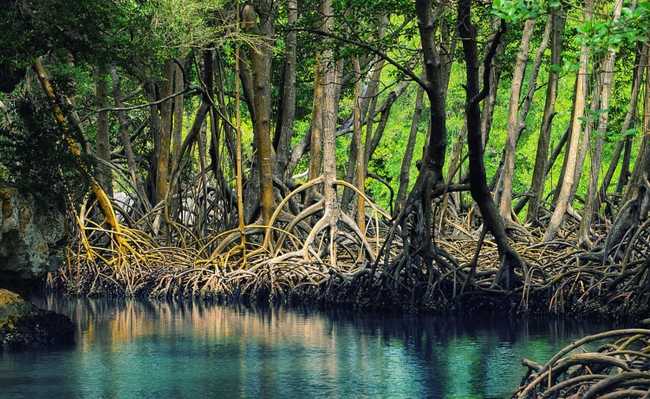What is environmental valuation?
Environmental valuation prices natural capital, which can bring advantages and problems

Edited and resized image by Michele Henderson is available on Unsplash
Humanity was used to using natural resources wildly until it realized that they are finite. In cases of natural resource crisis, the impacts are felt by everyone, as is common in periods of drought. In Brazil, the drought creates an energy deficiency, since hydroelectric plants are the main source of energy in the country, causing productive losses in companies and cuts in the distribution of water to the population. We have several examples of how we are affected by nature and that it will not be there forever providing us ecosystem services if we continue with an inconsequential economic model, so it is necessary to rethink the way companies and people deal with natural resources. As we live in a society where capital is very important, a vision was created that tries to insert nature in this context through the concept of natural capital.
- What are ecosystem services? Understand
What is natural capital?
Natural capital is the stock of natural resources (water, air, soil, plants, etc.) that produce a flow of goods and services to people through ecosystem services. According to certain views, there are different forms of capital, such as cultural, financial, intellectual capital, among others (other views are more restrictive as to the applicability of the concept)... But it is natural capital that supports all the others.
Preserving natural capital is essential; humanity has already understood this relationship of mutual dependence and is beginning to act. An instrument that helps to better understand and visualize the importance of nature is the valuation of natural capital.
What is natural capital valuation?
Attributing a value to the air we breathe or the water in rivers seems and is very difficult. The valuation of natural capital is an instrument that tries to estimate an economic value or, in other words, to price the goods and services provided by nature.
For this it is necessary to stipulate a plausible economic value, this is done through the relationship between what the environment is capable of providing and the value of other goods and services already existing in the economy. With the economic valuation of natural capital it is possible to attribute a monetary value to the resources of the environment.
There are two types of values assigned to ecosystem services: use value (direct, indirect, option) and non-use value. The sum of these values corresponds to the economic value of the environmental resources (Vera).
The use value can have three aspects: direct use (logging, visual beauty, recreation); indirect use (carbon capture, water cycle, pollination) and option use (knowing that a service exists, knowing that if you need it in the future, it will be available, for example medicinal properties not yet discovered in forests).
And finally, the non-use value is the one that brings the satisfaction that present and future generations will be able to enjoy nature or that certain species or ecosystems exist. Therefore, the economic valuation of a natural resource is based on determining how much better or worse people's well-being is due to changes in the amount of ecosystem goods and services, whether by use or not.
There are several methodologies for environmental valuation, each one more appropriate for certain objects of study, and require different analyses. For example: for a monetary quantification there are the following methods:
- Contingent valuation - through questionnaires, people give a value of how much they would be willing to pay or compensate for a good or service of natural capital;
- Hedonic prices - is the valuation by environmental factors that influence the market price - for example a house located in a wooded neighborhood;
- Travel costs - is the amount spent to visit a place to enjoy nature, such as weather, entrance fee, etc.;
- Response dose - treats environmental quality as a production factor, changes in the quality of the natural capital used affect production levels and, consequently, the price of products;
- Substitute goods market - estimate the price for the replacement by another existing in the market;
- Avoided costs - infers a value to the environmental resource by the impacts avoided by maintaining them;
- Control cost - expenses necessary to maintain the quality of natural resources - for example: a water treatment plant;
- Replacement cost - cost of repairing the damage caused;
- Opportunity cost - social and economic cost of preserving the environmental resource.
One of the limitations of valuation is that, in many cases, externalities are not fully understood, and end up not covering all the real aspects of the situation.
Example of a real case
An example was the creation and valuation of RPPNs (Private Reserve of Natural Heritage) of Fundação Grupo Boticário. In 2015, a study was carried out on the application of economic valuation in one of its reserves in Paraná. The study was carried out in the Conservation Unit (UC) called Reserva Natural Salto Morato, with an area of 2,253 hectares, in order to demonstrate that in addition to the obvious environmental benefits, there are also financial benefits. Through the Oasis Project, which uses payment for environmental services (PES), it was possible to create methodologies that enable the valuation of the area.
The valuation was created by comparing two scenarios, one with the existence of the reserve and the other without the reserve. The parameters evaluated and the values obtained were:- Public use: referring to visitation of the area for the local economy - R$ 858,780;
- Avoided soil erosion: referring to the conservation of vegetation to control erosion and sedimentation, calculated based on the cost of removing sediment from water bodies - R$ 258,873;
- Water supply: one of the reserves in the area supplies the community downstream, so the cost of providing potable water was estimated - R$ 36,024;
- Ecological ICMS: survey of earnings from the Circulation Tax on Merchandise (ICMS) for the Ecological area - R$ 100,100;
- Impact of local contracts and acquisitions: related to expenses with management of the area, employees and suppliers - R$ 452,346;
- Environmental education: related to investments in environmental education programs - R$ 6,305;
- Scientific research: referring to the costs of carrying out scientific research in the area - R$ 65,000;
- Reduction of Emissions from Deforestation and Degradation (Redd): estimate of the volume of greenhouse gases captured in the absence of UC - R$ 121,990;
- Carbon sequestration by restoration: estimated amount of carbon (t/ha) sequestered - R$ 282,580;
- Livestock avoided: survey of the amount of methane generation avoided by livestock farming - R$2,310;
- Total: BRL 2,184,308.00.
Before the creation of the RPPN, this area was intended for agriculture and cattle raising, an estimate of the income generated had a great advantage in changing the use of the land. Farming would generate R$ 150,000/year, while the conservation of the area could generate R$ 666 thousand/year. With the explicit benefits of ecosystem services expressed in cash, the importance of preserving reserves can be better understood and given more support from society.
The trees themselves also have added value relative to the services provided, for example, an urban tree may have a higher monetary value than a tree in the native forest. This is because the trees in the city are found in smaller quantities, making them more valuable.
- Benefits of trees and their value
Valuation applied to companies
Companies are very concerned about financial capital but it is still not usual to understand or consider natural capital. Organizations must understand that without natural capital there is no production, if they depend on natural resources a scarcity will affect business productivity and finances. Therefore, it is necessary to include the management and valuation of natural capital for companies that want to survive in the future, according to some views.
Valuing natural capital can be used as a tool to correctly allocate investments, assist in public and private decision-making, define types of land use, identify important conservation areas or simply to show the value of nature and reduce its degradation. They can also help in making decisions to mitigate risks and reduce impacts. These measures introduce the concept of the green economy, “an economy that results in human well-being and social equity, while significantly reducing environmental risks and ecological deficiencies”. Thus, investment in natural capital is the basis for economic growth towards clean technologies and sustainable development resulting in a measure to mitigate climate change.
Cambridge University has created a very interesting game (in English) that introduces the valuation of natural capital by simulating a company where you invest in stocks related to the natural resources of your choice and are able to analyze the gains obtained.
Companies from different sectors must be increasingly engaged in the insertion of natural capital not only to guarantee its production, but also to maintain a good image and competitiveness in the market. To help organizations generate reliable information, the Natural Capital Protocol was created. The protocol helps in making better decisions including our interaction with the environment, more specifically natural capital. Until now most questions about natural capital have been excluded or when included have been inconsistent, open to interpretation and limited. The protocol provides a standardized framework for identifying, measuring and valuing impacts and dependencies relating to natural capital.
One of the main challenges in economics is determining how much of an ecosystem must be converted into products and how much must be left intact to generate ecosystem services. Society is still much more concerned with the generation of products, so we must start to attribute values and encourage the valuation of more and more areas to have a clearer sense of how much we are losing and move towards a sustainable development model. Knowing how much an ecosystem is worth, it is possible to apply tools such as payment for environmental services, the PSA. Watch the video on valuing ecosystem services.
Reviews
Many criticisms are made to the theme, by organizations and social movements, which consider the valuation of natural capital as a false solution that takes the form of a green capitalism. Behind a technical facade, there is acceptance that carbon, water and biodiversity are subject to appropriation and negotiation by contract and that they constitute new global chains of commodities.
The main criticism made to the valuation of natural capital revolves around this issue and the denial of the possibility of attributing monetary values to natural goods. Critics of the idea of valuing the environment with traditional mechanisms consider the valuation of natural capital to be another name for the so-called market environmentalism.
When natural assets are valued in cash, it is possible to carry out environmental compensation operations in which a natural area or natural resources that have been destroyed can be compensated for by other areas and resources, as in the case of Environmental Reserve Quotas (CRA). Critics do not consider this reasonable, as it would be impossible to accurately compare the natural value of one location with the natural value of another. This mechanism is seen as the fomentation of a new market, where the processes and products supplied by nature are merchandise. Whether it's water and air purification, the generation of soil nutrients for agriculture, pollination, the supply of inputs for biotechnology, among others. These criticisms call into question the efficiency of this method in relation to environmental conservation, and with regard to social inclusion.










